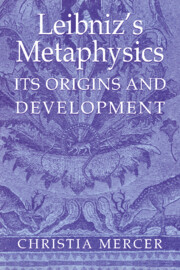Book contents
- Frontmatter
- Contents
- Acknowledgments
- References to Leibniz's works
- Introduction: first truths and half truths
- PART ONE METAPHYSICS OF METHOD
- PART TWO METAPHYSICS OF SUBSTANCE
- 2 Aristotelian assumptions, 1668–69
- 3 Original conception of substance, 1669
- 4 Second conception of substance, 1669–early 1671
- PART THREE METAPHYSICS OF DIVINITY
- PART FOUR METAPHYSICS
- Appendix I (Not exactly) First truths
- Appendix II Leibniz's original assumptions
- Bibliography
- Index Locorum
- Index
2 - Aristotelian assumptions, 1668–69
from PART TWO - METAPHYSICS OF SUBSTANCE
Published online by Cambridge University Press: 12 March 2010
- Frontmatter
- Contents
- Acknowledgments
- References to Leibniz's works
- Introduction: first truths and half truths
- PART ONE METAPHYSICS OF METHOD
- PART TWO METAPHYSICS OF SUBSTANCE
- 2 Aristotelian assumptions, 1668–69
- 3 Original conception of substance, 1669
- 4 Second conception of substance, 1669–early 1671
- PART THREE METAPHYSICS OF DIVINITY
- PART FOUR METAPHYSICS
- Appendix I (Not exactly) First truths
- Appendix II Leibniz's original assumptions
- Bibliography
- Index Locorum
- Index
Summary
In 1545, Catholic dignitaries from all over Europe convened in the imperial city of Trent to discuss the doctrinal and political problems produced by Luther and his reformation followers. It would take the Council three sessions and nearly twenty years to reach its conclusions. In the Papal bull announcing the Council, Pope Paul III asserted that two of its goals were to heal the schism perpetrated by the Protestant rebels and to reform the church. As much as its participants may have intended conciliation, their conclusions contradicted the Protestants on several crucial points and thereby guaranteed continued religious strife. Despite the failure in its task of reconciliation, however, the Council did succeed in asserting policy that would influence Christian Europe for centuries.
In 1668, Leibniz attempted to succeed where the sixteenth-century bishops and cardinals had failed. Under the encouragement of his friend and patron, Baron Johann Christian von Boineburg, Leibniz commenced work on an ambitious theological project entitled Catholic demonstrations. One of the explicit motivations behind the project was to effect a reconciliation between Roman Catholics and Lutherans. Leibniz hoped specifically to solve certain theological problems in a way that would satisfy members of both faiths and that would remain consistent with the doctrinal pronouncements of the Council of Trent. As I have argued, Leibniz intended to construct a true metaphysics that would answer the grand philosophical questions while remaining consistent with Christian doctrine.
- Type
- Chapter
- Information
- Leibniz's MetaphysicsIts Origins and Development, pp. 63 - 98Publisher: Cambridge University PressPrint publication year: 2001

